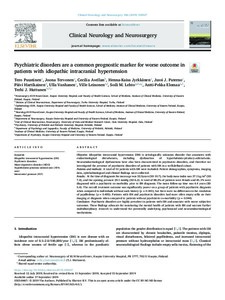Psychiatric disorders are a common prognostic marker for worse outcome in patients with idiopathic intracranial hypertension
Vanhanen U; Elomaa AP; Leinonen V; Jyrkkänen HK; Hartikainen P; Avellan C; Paterno JJ; Tervonen J; Puustinen T; Lehto SM; Huttunen TJ
Psychiatric disorders are a common prognostic marker for worse outcome in patients with idiopathic intracranial hypertension
Vanhanen U
Elomaa AP
Leinonen V
Jyrkkänen HK
Hartikainen P
Avellan C
Paterno JJ
Tervonen J
Puustinen T
Lehto SM
Huttunen TJ
ELSEVIER
Julkaisun pysyvä osoite on:
https://urn.fi/URN:NBN:fi-fe2021042823059
https://urn.fi/URN:NBN:fi-fe2021042823059
Tiivistelmä
Objective: Idiopathic intracranial hypertension (IIH) is aetiologically unknown disorder that associates with endocrinological disturbances, including dysfunction of hypothalamic-pituitary-adrenal-axis. Neuroendocrinological dysfunctions have also been characterized in psychiatric disorders, and therefore we investigated the presence of psychiatric disorders of patients with IIH in a well-defined cohort.Patients and methods: A total of 51 patients with IIH were included. Patient demographics, symptoms, imaging data, ophthalmological and clinical findings were collected.Results: At the time of diagnosis the mean age was 32.5years (SD 10.7), the body mass index was 37.1 kg/m(2) (SD 7.4), and the opening pressure 29.1 mmHg (SD 6.2). A total of 88.2% of patients were female and 45.1% were diagnosed with a psychiatric co-morbidity prior to IIH diagnosis. The mean follow-up time was 4.4 years (SD 5.4). The overall treatment outcome was significantly poorer on a group of patients with psychiatric diagnosis when compared to individuals without such history (p = 0.001), but there were no differences in the resolution of papilledema (p = 0.405). Patients with IIH and psychiatric disorders had more often empty sella on their imaging at diagnosis when compared to patients without psychiatric co-morbidity (p = 0.044).Conclusion: Psychiatric disorders are highly prevalent in patients with IIH and associate with worse subjective outcomes. These findings advocate for monitoring the mental health of patients with IIH and warrant further multidisciplinary research to understand the potentially underlying psychosocial and neuroendocrinological mechanisms.
Kokoelmat
- Rinnakkaistallenteet [19207]
